New From Onya! Comparing New Onya Pure to Onya Outback.
- Blog New From Onya! Comparing New Onya Pure to Onya Outback.
Our friends at Onya have a new carrier out and we love it! The Onya Pure is a great carrier for those who hike and want a more breathable product. When comparison shopping, it may be difficult to tell the difference between the new Onya Pure and the Onya Outback carriers. Jessica is a trained babywearing consultant and manages social media for Hike it Baby. Using the help of our Branch Ambassador Teammates, she has gathered testimonials and research to put together a side-by-side comparison of the two carriers to help you decide on your next purchase.
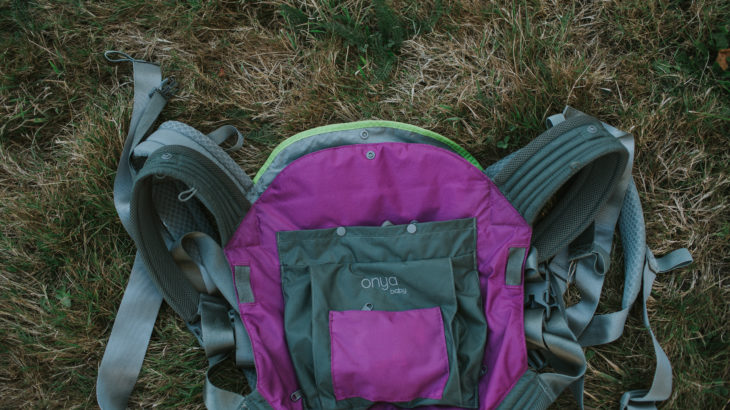 I’ve had the opportunity to try the Outback and Pure Onya Baby carriers. While there are some great similarities between the two (angled seat, ability to cross straps, and general design) there are definitely a few differences.
I’ve had the opportunity to try the Outback and Pure Onya Baby carriers. While there are some great similarities between the two (angled seat, ability to cross straps, and general design) there are definitely a few differences.
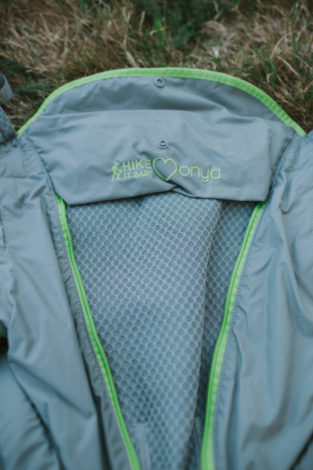 Onya Baby removed the pocket and high chair feature of the Outback to have a leaner carrier. This is a bare bones, no frills carrier. The Pure has an ultralight 3D hex mesh inner lining, a lightweight outer layer, and a zippered vent that creates a cooler, lighter carrier. The Pure’s unique 3D hex mesh provides a slight bit of stretch which I find great for getting a deeper seat on bigger children. The vent zips down and is snapped into the top of the carrier making it convenient and easy to keep open. I’ve had the opportunity to try other carriers with mesh interiors and zip vents in the past. My complaint has always been that the zip vent doesn’t neatly tuck or fold out of the way. The Onya Baby Pure vent section folds neatly out of the way.
Onya Baby removed the pocket and high chair feature of the Outback to have a leaner carrier. This is a bare bones, no frills carrier. The Pure has an ultralight 3D hex mesh inner lining, a lightweight outer layer, and a zippered vent that creates a cooler, lighter carrier. The Pure’s unique 3D hex mesh provides a slight bit of stretch which I find great for getting a deeper seat on bigger children. The vent zips down and is snapped into the top of the carrier making it convenient and easy to keep open. I’ve had the opportunity to try other carriers with mesh interiors and zip vents in the past. My complaint has always been that the zip vent doesn’t neatly tuck or fold out of the way. The Onya Baby Pure vent section folds neatly out of the way.
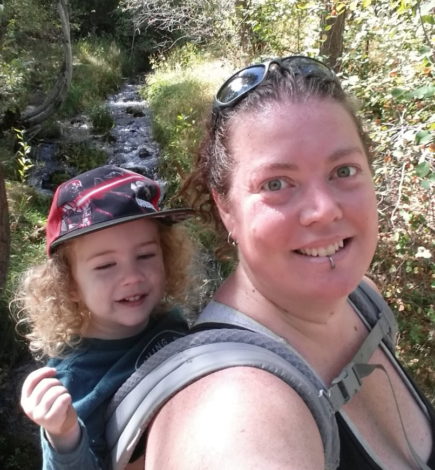 Joey, a Branch Ambassador for Utah County, says:
Joey, a Branch Ambassador for Utah County, says:
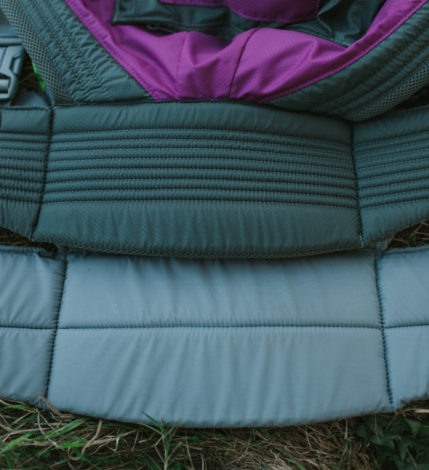 Heading to the waistband, I noticed a few differences here. The waistband on the Pure is slightly larger, has a new buckle, and webbing on each side of the buckle so you can pull from either side. The new safety buckle on the Pure is wonderful. I find as an educator most people don’t utilize the elastic band near the buckle when buckling the waistband. This is a secondary safety in case the buckle were to break. Onya Baby’s new safety buckle is a two step process to open. What’s amazing is that while it’s a two step process, I can do it with one hand. This buckle style is also utilized on the straps.
Heading to the waistband, I noticed a few differences here. The waistband on the Pure is slightly larger, has a new buckle, and webbing on each side of the buckle so you can pull from either side. The new safety buckle on the Pure is wonderful. I find as an educator most people don’t utilize the elastic band near the buckle when buckling the waistband. This is a secondary safety in case the buckle were to break. Onya Baby’s new safety buckle is a two step process to open. What’s amazing is that while it’s a two step process, I can do it with one hand. This buckle style is also utilized on the straps.
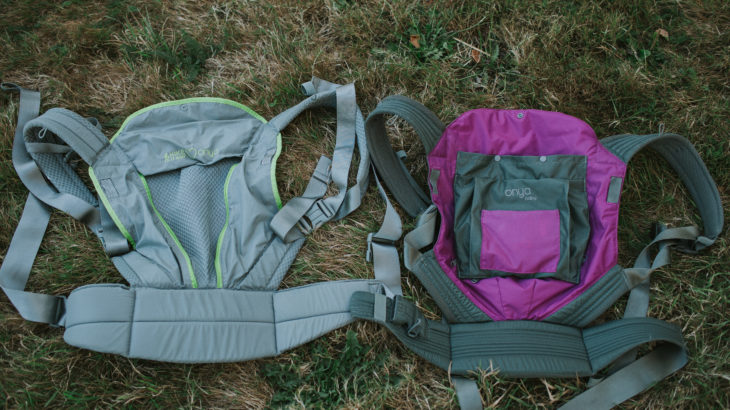 Hopefully this breakdown helps you decide if the Onya Baby Pure is right for you! I know I’ve made the Onya Baby Pure my go-to carrier right now since it’s humid and muggy in Wisconsin. I’m excited to try this in winter and see if the wicking material also keeps us warmer since it wicks away moisture.
Jessica Featherstone is a Hike it Baby Branch Ambassador, as well as a trained babywearing consultant with the Center for Babywearing Studies and a volunteer educator with the Milwaukee Babywearers.
Hopefully this breakdown helps you decide if the Onya Baby Pure is right for you! I know I’ve made the Onya Baby Pure my go-to carrier right now since it’s humid and muggy in Wisconsin. I’m excited to try this in winter and see if the wicking material also keeps us warmer since it wicks away moisture.
Jessica Featherstone is a Hike it Baby Branch Ambassador, as well as a trained babywearing consultant with the Center for Babywearing Studies and a volunteer educator with the Milwaukee Babywearers.
 I’ve had the opportunity to try the Outback and Pure Onya Baby carriers. While there are some great similarities between the two (angled seat, ability to cross straps, and general design) there are definitely a few differences.
I’ve had the opportunity to try the Outback and Pure Onya Baby carriers. While there are some great similarities between the two (angled seat, ability to cross straps, and general design) there are definitely a few differences.
Let’s start with the major difference: the zip panel.
 Onya Baby removed the pocket and high chair feature of the Outback to have a leaner carrier. This is a bare bones, no frills carrier. The Pure has an ultralight 3D hex mesh inner lining, a lightweight outer layer, and a zippered vent that creates a cooler, lighter carrier. The Pure’s unique 3D hex mesh provides a slight bit of stretch which I find great for getting a deeper seat on bigger children. The vent zips down and is snapped into the top of the carrier making it convenient and easy to keep open. I’ve had the opportunity to try other carriers with mesh interiors and zip vents in the past. My complaint has always been that the zip vent doesn’t neatly tuck or fold out of the way. The Onya Baby Pure vent section folds neatly out of the way.
Onya Baby removed the pocket and high chair feature of the Outback to have a leaner carrier. This is a bare bones, no frills carrier. The Pure has an ultralight 3D hex mesh inner lining, a lightweight outer layer, and a zippered vent that creates a cooler, lighter carrier. The Pure’s unique 3D hex mesh provides a slight bit of stretch which I find great for getting a deeper seat on bigger children. The vent zips down and is snapped into the top of the carrier making it convenient and easy to keep open. I’ve had the opportunity to try other carriers with mesh interiors and zip vents in the past. My complaint has always been that the zip vent doesn’t neatly tuck or fold out of the way. The Onya Baby Pure vent section folds neatly out of the way.
The major selling point of the Pure is it’s more breathable than the rest of the Onya Baby line.
The Pure does provide quite a bit more airflow between myself and my toddler. The 3D hex mesh wicks away moisture and the outer layer is thin yet supportive. With my experience as an educator, I’ve had the opportunity to try almost every major brand and style of carrier. I can say that the Onya Baby Pure is a very lightweight carrier and very breathable. It’s doing well in the muggy, humid Wisconsin summer. Joey, a Branch Ambassador for Utah County, says:
Joey, a Branch Ambassador for Utah County, says:
“My biggest complaint with other SSC's is how hot it can be for you and baby. I've worn this on hikes where my son has ended up with visibly sweaty clothes, not to mention mine too and only ONCE in 95 degree F weather with humidity around 40%+ did my son end up with visibly sweaty pants! Your child will also be happier longer in this breathable carrier. Happy kid, Happy mom!”
The outer material is also easy to clean and dries quickly. Which is perfect for hiking with small children.The Waistband
 Heading to the waistband, I noticed a few differences here. The waistband on the Pure is slightly larger, has a new buckle, and webbing on each side of the buckle so you can pull from either side. The new safety buckle on the Pure is wonderful. I find as an educator most people don’t utilize the elastic band near the buckle when buckling the waistband. This is a secondary safety in case the buckle were to break. Onya Baby’s new safety buckle is a two step process to open. What’s amazing is that while it’s a two step process, I can do it with one hand. This buckle style is also utilized on the straps.
Heading to the waistband, I noticed a few differences here. The waistband on the Pure is slightly larger, has a new buckle, and webbing on each side of the buckle so you can pull from either side. The new safety buckle on the Pure is wonderful. I find as an educator most people don’t utilize the elastic band near the buckle when buckling the waistband. This is a secondary safety in case the buckle were to break. Onya Baby’s new safety buckle is a two step process to open. What’s amazing is that while it’s a two step process, I can do it with one hand. This buckle style is also utilized on the straps.
Joey says “I LOVE the new Pure's safety buckle! You can unbuckle it with one hand, just took me a few tries to figure it out.”
Downsides.
The two downsides to the Pure is that it doesn’t have a sleeping hood or a pocket. While it’s not completely necessary, I know that some people like to utilize the hood for discreet nursing and for keeping little heads from rolling back when sleeping. As for the pocket, I just added the Onya Baby Hipster Pouch and this holds everything I need on the trail. Hopefully this breakdown helps you decide if the Onya Baby Pure is right for you! I know I’ve made the Onya Baby Pure my go-to carrier right now since it’s humid and muggy in Wisconsin. I’m excited to try this in winter and see if the wicking material also keeps us warmer since it wicks away moisture.
Jessica Featherstone is a Hike it Baby Branch Ambassador, as well as a trained babywearing consultant with the Center for Babywearing Studies and a volunteer educator with the Milwaukee Babywearers.
Hopefully this breakdown helps you decide if the Onya Baby Pure is right for you! I know I’ve made the Onya Baby Pure my go-to carrier right now since it’s humid and muggy in Wisconsin. I’m excited to try this in winter and see if the wicking material also keeps us warmer since it wicks away moisture.
Jessica Featherstone is a Hike it Baby Branch Ambassador, as well as a trained babywearing consultant with the Center for Babywearing Studies and a volunteer educator with the Milwaukee Babywearers.
Photo Credits: Ashley Scheider, Joey Johnson
Some of the brands listed in this piece are sponsors of Hike it Baby. We may have received financial compensation and/or product from the company but did not ask for this for inclusion in this blog. We are writing this blog based on personal experience. We do not review products we have not personally used. We stand behind all of the products we share with you because we think they will make your life on trail a little bit easier. We are disclosing this in accordance with the Federal Trade Commission’s 16 CFR, Part 255: “Guides Concerning the Use of Endorsements and Testimonials in Advertising.”
Related Content


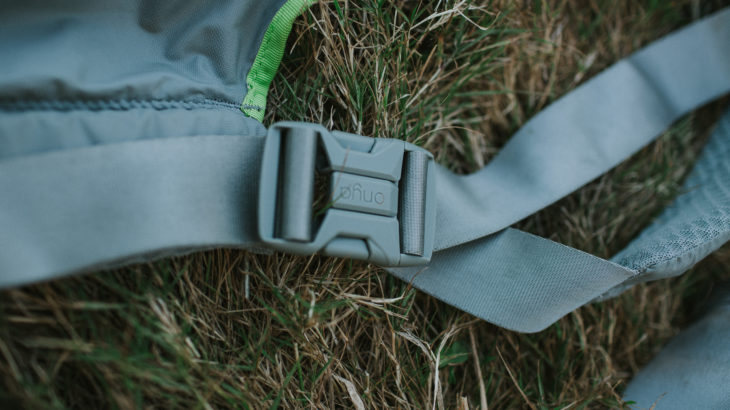


Comments